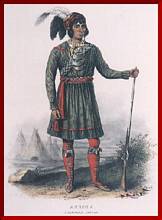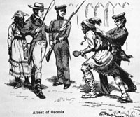

In 1821, the U.S. Government bought Florida from Spain for
five million dollars and began urging Indians to move west. A series of
three Seminole wars were fought between 1832 and 1858 between the
Seminoles who loved their land and the U.S. government who wanted this
land for settlement.
History of Bay County Florida : Seminole Indians
When the Indian Removal Act was passed in 1830, the U.S.
government
wanted to send the Seminoles to Oklahoma. causing yet another war --
the Second Seminole War.
Those years brought out two legendary Seminole leaders - the famous
warrior Osceola (a.k.a. William Powell) and the inspirational medicine
man Abiaka (a.k.a. Sam Jones). Elegant in dress, handsome of face,
passionate in nature and giant of ego, Osceola masterminded successful
battles against five baffled U.S. generals, murdered the United State's
Indian agent, took punitive action against any who cooperated with the
white man and stood as a national manifestation of the Seminoles'
strong reputation for non-surrender. Osceola
was not a chief with the heritage of a Micanopy or Jumper, but his
skill as an orator and his bravado in conflict earned him great
influence over Seminole war actions.
Osceola's death in prison at Fort Moultrie, SC, was noted on front
pages around the world. In 1838 he was the most famous Native
American.
Though his exploits were not as well publicized, Seminole medicine man
Abiaka may have been more important to the internal Seminole war
machine than Osceola. Wise old Sam Jones kept the resistance fueled
before and after Osceola's period of prominence and, when the fighting
had concluded, was the only major Seminole leader to remain in Florida.
Official
Seminole Tribe of Florida: History:
Osceola and Abiaka
"The word Osceola is a corrupted English
pronunciation of the Seminole name for Black Drink Singer. During
purification rites, a Seminole warrior drinks a black liquid brewed
from the leaves of holly bushes. The word "Assin-ye-o-la" is the long,
drawn-out cry that accompanied the ceremonial drinking." From
Osceola: NPS page, cited below.
After defeating the U.S. in the early battles of the Second Seminole
War, Seminole leader Osceola was captured by the United States on Oct.
20, 1837, when U.S. troops said they wanted a truce to talk peace. This
event remains today one of the blackest marks in American military
history.

Oct. 20, 1837, under flag of truce. |
artist Robert John Curtis, 1838. |
|
In December 1837, Captain Pitcairn Morrison of the 4th U.S.
Infantry transferred Osceola and 202 other prisoners to Fort Moultrie
in South Carolina. Osceola was not locked in a prison cell but housed
in the Fort Moultrie Officers' Quarters. He was also permitted the
privelege of "liberty within the walls" of the fort and received visits
from the elite of Charleston society. Osceola
also spent entire mornings posing for many artists
Death came for Osceola at 6:20 p.m. on January 30, 1838. He lived only
3 months and 10 days in captivity.
Osceola's life and the fact of his untimely death combine to make his
story seem more legendary than real. Though much about Osceola's life
will remain a mystery, his role as defender of his people is
undeniable.
Osceola:
National Park Service, Fort Sumter National Monument, Fort Moultrie
page. Please read End of the Journey, describing his manner of
death, on this page.
[Footnote: When the third war ended in May 1858, more than 3,000
Seminoles had been moved West. About 200 to 300 remained hidden in the
Florida swamps. Today, more than 2,000 Seminoles live on six
reservations in the state ñ located in Hollywood, Big Cypress,
Brighton, Immokalee, Ft. Pierce, and Tampa. There was never a peace
treaty signed and the Seminole have always been an independent nation.]
Bibliography
Boyd, Mark F. "Asi-Yaholo or
Osceola." Florida Historical Quarterly 30 (July, 1951): 249-305.
Covington, James W. The Seminoles of Florida. Gainesville: University
Presses of Florida, 1993.
Goggin, John M. "Osceola: Portraits, Features, and Dress." Florida
Historical Quarterly 33 (January-April, 1955): 161-192.
Hartley, William, and Ellen Hartley. Osceola: The Unconquered Indian.
New York: Hawthorn Books, 1973.
Mahon, John K. History of the Second Seminole War, 1835-1842.
Gainesville: University Presses of Florida, 1967.
Wickman, Patricia R. Osceola's Legacy. Tuscaloosa: University of
Alabama Press, 1991.
![]() Return to
Indigenous Peoples' Literature
Return to
Indigenous Peoples' Literature
Compiled by: Glenn Welker
This site has been accessed over 10,000,000 times since February 8,
1996.